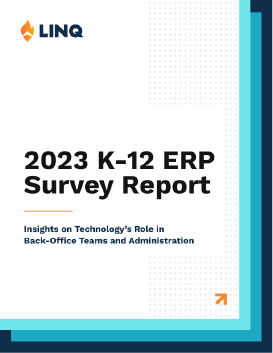Tech stack?
Platform?
Technology integration in schools goes by different names, but the benefits are clear—systems that work together simplify processes, help teams collaborate, and provide deeper insights for data-driven decision making. Integrated technology can also enhance cybersecurity by bringing all your tools together under a single, reputable provider rather than relying on disparate systems.
However, schools and districts have many pressing issues to deal with each day, and thinking about a holistic technology integration plan isn’t always at the top of the list. That’s understandable. But many day-to-day challenges might be better addressed in the long run with integrated tools that help teams solve problems and simplify workflows together.
Think about integrated technologies in a K‑12 business office like a symphony orchestra. Just as an orchestra combines various instruments and musicians to create a harmonious and powerful performance, integrated technologies unite digital tools and systems to orchestrate efficiency, productivity, and success in the back office.
Each orchestra member represents a specific technology or system, such as ERP, digital forms, workflow automation, district nutrition, and more. But how does it all come together?
What is technology integration in schools…really?
Integration is a loaded term in today’s ever-evolving technology landscape. At its core, integration incorporates new technologies into existing systems, processes, and workflows. It involves using technology to improve and enhance existing processes and systems rather than simply replacing them with something new or different. Integration can take multiple forms, such as:
- Adding new hardware or software to an existing system or workflow to enhance functionality
- Automating manual processes using technology to reduce the time and effort needed to perform routine tasks.
- Creating new processes and workflows that take advantage of the capabilities of new technologies.
- Centralizing data management and analysis to improve real-time reporting and insights through data collection, storage, and research technologies
Many of the individual technologies schools and districts rely on deliver value for their users and stakeholders. However, integrating technologies can take this performance to the next level, helping K‑12 business professionals operate more efficiently, promoting collaboration, improving the user-experience, supporting data-driven decision-making, and cultivating innovation.
Only 20% of K‑12 business professionals surveyed in LINQ’s recent K‑12 ERP Survey Report told us their technology is fully integrated. The majority still rely on partially integrated systems. This gap creates an opportunity for most to gain major improvements by modernizing and integrating their technology platform.
Without fully integrated technology systems and processes, schools and districts experience:
- Data inconsistency and errors
- Duplicative and complex workflows
- Time-consuming multiple logins
- Lack of holistic data insight
- Higher maintenance costs
- Elevated cybersecurity risks
- Lack of scalability as needs increase
How technology integration makes a difference for K‑12 administration, finance, and HR staff
There are plenty of opportunities for integration to make a difference. In a K‑12 school district’s back office, various administrative tasks and functions are essential for the smooth, efficient district operations. Integrated software can simplify processes, giving staff members more time to focus on high-impact tasks—like writing more compelling recruiting ads and job postings, nurturing highly qualified candidates through the hiring process, and ensuring new hires are fully onboarded and prepared for their first day on the job.
Integrated technology helps everyone focus more energy on:
• Recruiting and hiring of staff, including teachers, administrators, and support personnel
• Managing employee contracts, benefits, and payroll
• Personalizing onboarding, training, and professional development
• Planning budgets, forecasting finances, and analyzing reports
• Overseeing the maintenance and repair of school buildings and facilities
• Ensuring data security and privacy compliance
Integrated school operations technology brings everyone together to making beautiful music
Just as each musician plays their part in contributing to the overall symphony, integrated technologies work in tandem to streamline workflows, facilitate communication, and optimize processes. They also provide centralized control and coordination, enabling seamless collaboration, and data sharing. This ensures that all departments in the district work together in harmony to support staff and improve student outcomes.
7 Steps to Successfully Implement Integrated School Technology
Getting started doesn’t have to be complicated. Asking the right questions and collaborating with all teams and stakeholders ensures you’re all playing from the same sheet of music. It starts with knowing what your school or district needs. From there, teams can align around software solutions, building total team buy-in along the way.
- Identify your goals: Determine what your district wants to achieve by integrating technologies. Are you looking to improve productivity, reduce costs, streamline processes, enhance communication, or boost innovation? Clearly define your objectives to guide your technology integration efforts.
- Assess your needs: Evaluate your current workflows and identify areas where technology can make a significant impact. Consider the specific challenges or bottlenecks you want to address. This analysis will help you prioritize the types of technologies that would be most beneficial for your organization.
- Research available technologies: Explore the market and research various technologies that align with your goals and needs. Look for tools, software, and systems that offer features and functionalities relevant to your business processes. Read buying guides, compare options, and seek recommendations from trusted sources or industry experts.
- Consult with IT to align with their needs, priorities, and suggestions: K‑12 technology leaders play a big role in any new software implementation. They’re also the tech experts who can ensure that new systems bring the capability, reliability, and cybersecurity that are critical to school and district operations.
- Develop an implementation plan: Outline a detailed plan for integrating technologies into your infrastructure. Identify the specific tools you will implement, determine the order of integration, and establish a timeline for each phase.
- Start small and scale up: Begin with a pilot project or a smaller-scale implementation to test the effectiveness and suitability of the chosen technologies. This approach allows you to identify potential challenges, fine-tune the integration process, and gain employee feedback before expanding to a larger scale.
- Monitor and evaluate: Regularly assess the impact of the integrated technologies on your business processes. Collect employee feedback, track key performance indicators (KPIs), and evaluate whether the integration delivers the desired outcomes. Use this data to make informed decisions about further optimizations or adjustments to the technology integration strategy.
Remember, technology integration is an ongoing process, and staying adaptable and open to incorporating new technologies as they emerge is essential. Regularly reassess your district’s goals and needs to ensure that the integrated technologies align with your organization’s objectives.
By bringing together various tools and systems, they create a cohesive and powerful ensemble that drives the organization forward, creating a harmonious and melodious workplace environment.
See how integrated technology is shaping the future of K‑12 operations
Our latest ERP research report dives into how tech-forward schools and districts are unlocking potential by integrating their technology systems. The report covers the latest industry research and includes exclusive findings from our detailed survey of K‑12 business and finance professionals. Get your copy now to see the top priorities, challenges, and objectives for leaders in education, and find out how your school or district can keep pace with the latest innovations.

